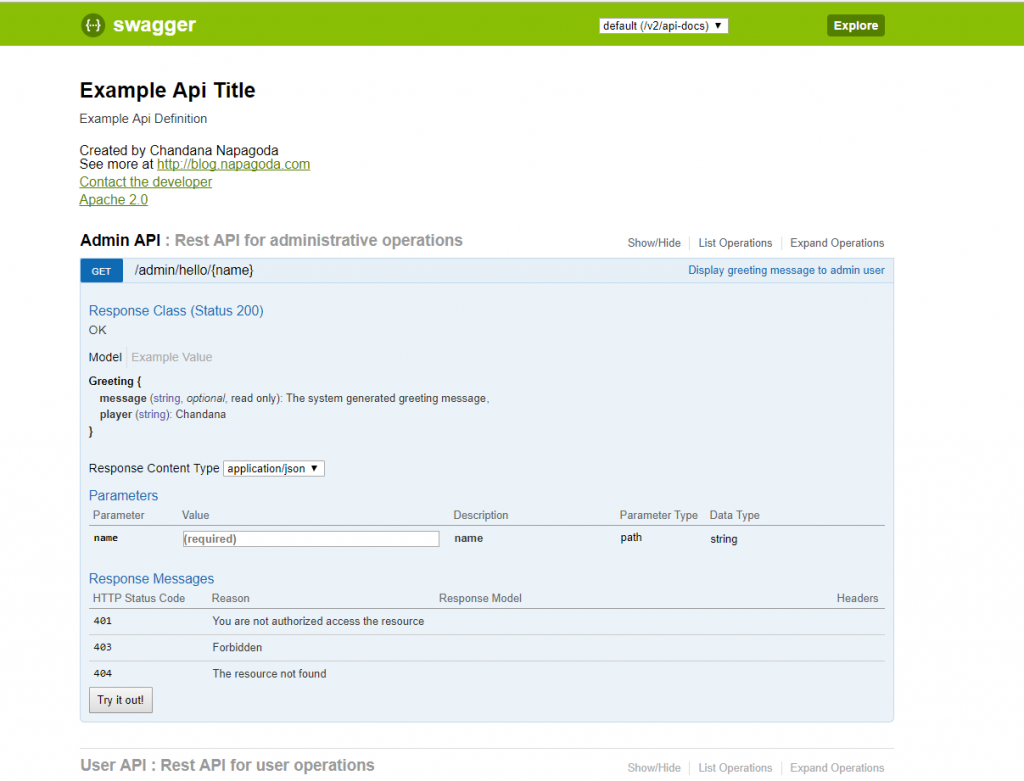译文链接:http://www.codeceo.com/article/swagger-spring-boot-rest-api.html
英文原文:Integrating Swagger with Spring Boot REST API
翻译作者:码农网 – Pansanday
Swagger是什么
Swagger(Swagger 2)是描述和记录REST API的一个规范。它指定了REST Web服务的格式,包括URL,资源,方法等。Swagger将从应用程序代码生成文档,并处理渲染部分。
在这篇文章中,我会将Swagger 2文档集成到基于Spring Boot的REST Web服务中。我将使用Springfox实现来生成swagger文档。如果你想知道是如何运行/构建Spring Boot项目的,请参考我上一篇文章。
Springfox提供了两个依赖关系来生成API文档和Swagger UI。如果你不希望将Swagger UI集成到你的API中,则无需添加Swagger UI依赖关系。
<dependency><groupId>io.springfox</groupId><artifactId>springfox-swagger2</artifactId><version>2.7.0</version></dependency>
<dependency><groupId>io.springfox</groupId><artifactId>springfox-swagger-ui</artifactId><version>2.7.0</version></dependency>
@ EnableSwagger2注解启用了Springfox Swagger在类中的支持。为了记录这个服务,Springfox使用了一个Docket类。Docket有助于配置要记录的服务,并通过名称等进行分组。后台是Springfox通过使用基于Spring配置的API语义,在运行时检查应用程序。换句话说,你必须创建一个使用Spring的@Configuration注解的Spring Java Configuration类。
在我的例子中,我会生成一个基于我添加的RestController类的swagger文档。
import springfox.documentation.spring.web.plugins.Docket;import springfox.documentation.swagger2.annotations.EnableSwagger2;
@Configuration@EnableSwagger2
public class ApplicationConfig {
@Bean
public Docket api() { return new Docket(DocumentationType.SWAGGER_2) .select() .apis(RequestHandlerSelectors.basePackage("com.chandana.helloworld.controllers")) .paths(PathSelectors.any()) .build();
}
}由于我添加了两个控制器,因此将分别对每个控制器相关的API进行分组(标记)。

开箱即用,Springfox提供了5种断言,它们分别是any,none,withClassAnnotation,withMethodAnnotation和basePackage【译者注:参见springfox.documentation.builders. RequestHandlerSelectors类】
ApiInfo
Swagger提供了一些默认值,例如“API文档”,“通过联系人电子邮件创建”,“Apache 2.0”。当然你可以通过添加apiInfo(ApiInfo apiInfo)方法来更改这些默认值。ApiInfo类包含有关API的自定义信息。
@Bean
public Docket api() { return new Docket(DocumentationType.SWAGGER_2)
.apiInfo(getApiInfo())
.select()
.apis(RequestHandlerSelectors.basePackage("com.chandana.helloworld.controllers"))
.paths(PathSelectors.any())
.build();
} private ApiInfo getApiInfo() {
Contact contact = new Contact("Chandana Napagoda", "http://blog.napagoda.com", "cnapagoda@gmail.com"); return new ApiInfoBuilder()
.title("Example Api Title")
.description("Example Api Definition")
.version("1.0.0")
.license("Apache 2.0")
.licenseUrl("http://www.apache.org/licenses/LICENSE-2.0")
.contact(contact)
.build();
}一旦添加了ApiInfo,生成的文档看起来就像这样:

Controller和POJO层文档
@Api注解用于说明每个控制器类(有点像类注释)。
@ApiOperation注解用于描述资源和方法。
@ApiResponse注解用于说明操作返回的其他响应值。例如:200 ok或202 accepted等
@ApiModelProperty注解用来描述POJO(Bean)类的属性(属性描述)。
添加上述注释后,最终生成的swagger文档如下所示:

Spring RestController类:
package com.chandana.helloworld.controllers;import com.chandana.helloworld.bean.Greeting;import io.swagger.annotations.Api;import io.swagger.annotations.ApiOperation;import io.swagger.annotations.ApiResponse;import io.swagger.annotations.ApiResponses;import org.springframework.web.bind.annotation.PathVariable;import org.springframework.web.bind.annotation.RequestMapping;import org.springframework.web.bind.annotation.RequestMethod;import org.springframework.web.bind.annotation.RestController;@RestController@RequestMapping("/api")@Api(value = "user", description = "Rest API for user operations", tags = "User API")public class HelloWorldController { @RequestMapping(value = "/hello/{name}", method = RequestMethod.GET, produces = "application/json") @ApiOperation(value = "Display greeting message to non-admin user", response = Greeting.class) @ApiResponses(value = { @ApiResponse(code = 200, message = "OK"), @ApiResponse(code = 404, message = "The resource not found")
}
) public Greeting message(@PathVariable String name) {
Greeting msg = new Greeting(name, "Hello " + name); return msg;
}
}Greeting模型类:
package com.chandana.helloworld.bean;import io.swagger.annotations.ApiModelProperty;public class Greeting { @ApiModelProperty(notes = "Provided user name", required =true) private String player; @ApiModelProperty(notes = "The system generated greeting message" , readOnly =true) private String message; public Greeting(String player, String message) { this.player = player; this.message = message;
} public String getPlayer() { return player;
} public void setPlayer(String player) { this.player = player;
} public String getMessage() { return message;
} public void setMessage(String message) { this.message = message;
}
}AppConfig类:
package com.chandana.helloworld.config;import org.springframework.context.annotation.Bean;import org.springframework.context.annotation.Configuration;import springfox.documentation.builders.ApiInfoBuilder;import springfox.documentation.builders.PathSelectors;import springfox.documentation.builders.RequestHandlerSelectors;import springfox.documentation.service.ApiInfo;import springfox.documentation.service.Contact;import springfox.documentation.spi.DocumentationType;import springfox.documentation.spring.web.plugins.Docket;import springfox.documentation.swagger2.annotations.EnableSwagger2;
@Configuration@EnableSwagger2public class ApplicationConfig {
@Bean
public Docket api() { return new Docket(DocumentationType.SWAGGER_2)
.apiInfo(getApiInfo())
.select()
.apis(RequestHandlerSelectors.basePackage("com.chandana.helloworld.controllers"))
.paths(PathSelectors.any())
.build();
} private ApiInfo getApiInfo() { Contact contact = new Contact("Chandana Napagoda", "http://blog.napagoda.com", "cnapagoda@gmail.com"); return new ApiInfoBuilder()
.title("Example Api Title")
.description("Example Api Definition")
.version("1.0.0")
.license("Apache 2.0")
.licenseUrl("http://www.apache.org/licenses/LICENSE-2.0")
.contact(contact)
.build();
}
}你也可以从我的GitHub repo 下载 Swagger Spring Boot Project 源代码。
译者注:
如果你对Spring Boot不是很熟悉,建议先fork下源码,因为有些依赖文中没有提到。
启动Spring Boot后,在浏览器中输入:127.0.0.1:8080/swagger-ui.html即可查看生成的文档信息。
在生成的文档页面中,可以输入参数,点击“Try it out!”即可进行接口测试,有点类似于Postman的功能。



 随时随地看视频
随时随地看视频




